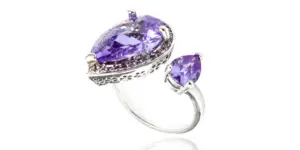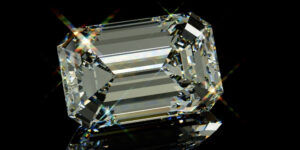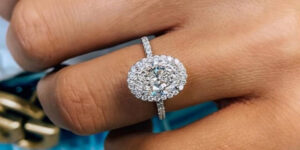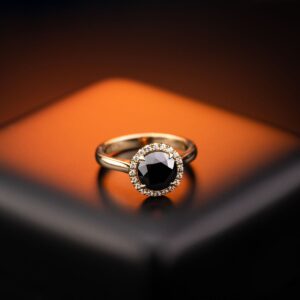Your engagement ring style depends on a lot of things, and if it’s a surprise – you didn’t choose it – it may also affect your wedding band design. If you’re in the position of choosing your own engagement ring, or you can drop some serious hints about what kind of ring you’d like, you will have to consider the band width.
How wide or thin your engagement ring is can determine what setting the diamond will be in, how many stones it can hold, whether you can get a pave or a solitaire, or a very complex design. So let’s see just how it influences your decision.
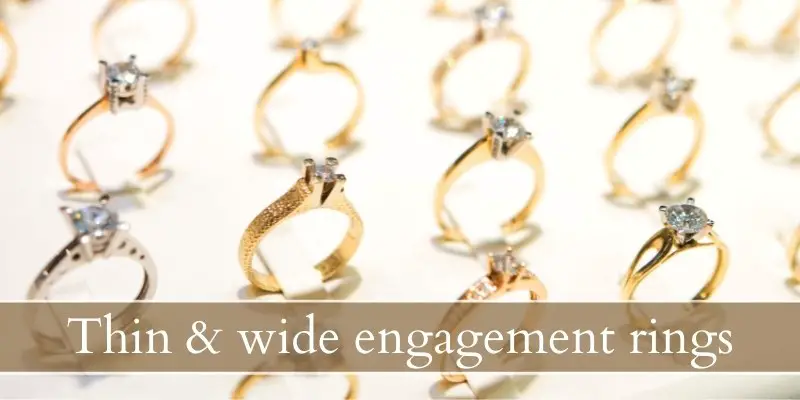
Engagement ring band width
Engagement rings come in various sizes, including the width of the band. Not the thickness, but the width across your finger. Thin bands (under 3mm) offer a dainty look and extra thin ones can be braided together for some complex designs. But thin bands can’t support stones larger than 1 carat, or some complex halo or cluster settings.
Wide engagement rings can take up a lot of space but offer a lot of design flexibility, may support more stones, and can even be diamond encrusted all the way. Really wide ones will mean you get a very thin wedding band, or you wear it on a different hand, unless you have long, long fingers.
Thin bands make for a dainty look
The current trend is the thin band engagement ring. Actually it’s for most rings, but today we’re focusing on engagement rings. A big plus for this style of band is that it offers a dainty look. A very delicate, thin, feminine look which is very fashionable this decade.
By comparison wider bands can look a bit overwhelming, especially if you’ve got very slender fingers. If they’re also very long it may work, but they key here is to emphasize your fingers and complement them.
Wide bands can support more stones
Because a diamond is a bit heavy, the ring band will have some support role. Generally the wider the band, the bigger the stone can be because its weight is distributer better.
If you’re going for large diamonds, like say a 4 ct white diamond you can’t expect a 2mm band to reasonably hold it in place. That diamond can and will flip from side to side, even if the band is thick (not wide, thick). You’d need a wider band, at least 3mm.
Wide bands can support pave, channel, and any other extra stones you may want on your ring. When a ring is encrusted, part of the material is used to make the prongs, and deep seats are drilled into the bands. So, the thinner the band the less you can do that. And if you do push a thin band so far, it has a very weak structure.
Read also: Sapphire VS Emerald
Thin bands need a very strong metal
If you want your thin band engagement ring to last, you need some serious metal in it. A gold 1.8mm band is simply too flimsy to not bend and warp with everyday wear. This risk goes up if you’re getting a higher karat gold, which is more malleable than 14k gold.
For a thin band, we recommend something very strong like platinum, titanium, or even palladium. You can always have the band plated with gold if you really love the warm yellow look.
An upside to choosing a thin band is the fact that it needs less metal, as it’s very thin. So for a thin ring made of platinum you won’t pay a very high price, since it’s a small amount of platinum. Just know that platinum is denser and thus heavier than gold, so it will weigh more than a gold ring of the same size.
Wide bands, due to their size, don’t need a particular metal. Of course, they do benefit from a stronger metal but for most cases it’s not necessary. A 5 mm band made of platinum will weigh quite a lot, compared to a 5 mm gold band.
Wide bands take up more space than a thin one
Wide ring bands simply take up more space on your finger, and you need to be able to freely use your hands as you need. So if you’re working with your hands and you need to be sure the band width won’t be an issue. A ring band too wide will get in the way and you won’t be able to close your hand properly, especially if it’s a tighter fit.
On the other hand a thin band may easily break or bend if you do a lot of work with your hands, especially if the diamond is set high and it will snag.
So take a look at your fingers and your profession, or your daily routine. Manual labor ? A wider band, like 3-4 mm will suffice. Anything wider than that may interfere with your mobility, especially when you add the wedding band later.
Do you do mostly office work or don’t do anything too strenuous with your hands ? A thin band will do just fine, assuming you’re not getting an extra large diamond or a halo setting that needs more support.
Is 1.5 mm band too thin ?
How thin is too thin ? A ring band measuring 1.5 mm across is pretty thin, and it won’t support any side stones, or even a 1 ct diamond. Your best bet is a smaller one, around 0.5-0.7 ct. Larger stones will flop from side to side, and the prongs may easily break.
A very thin 1.5 mm band is better for very delicate patterns, like fine engraving, twists, braids, or those very fashionable nature-themed rings (leaves, vines, etc) .
How to choose your wedding band width
Once you’ve chosen your engagement ring width, it’s wise to think about your wedding ring too. Most people choose to wear their engagement ring and wedding ring together, on the same finger. If you’d like to wear that combination, you will have to take into account the total width of both rings.
You also need to match the rings, even if it means just finding a ring design that doesn’t totally clash with your engagement ring. Here’s the top 3 points to have in mind when looking for a wedding band.
Consider your engagement ring style width
For example a very wide wedding band – say 6 mm – is going to match a thinner engagement ring, like a 2 mm. The total width would be 8mm. If you get a larger engagement ring, like a 4 mm, you have 10 mm of metal on your finger, and it can easily be too much, or get in the way of day to day life.
A thin band always looks great paired with a wide band, simply for contrast. But when the total width gets in the way, you may want to scale one of the down.
In my case, I received a 2 mm engagement ring, and chose a 3 mm wedding band. My total width is 5 mm, as my fingers are fairly thin yet short (small hands), and I do a lot of office work. I could’ve went with a wider wedding band, like a 4 or even a 5, but then my finger would’ve looked a bit like an encased sausage.
My husband chose a 4 mm wedding band, as he doesn’t wear jewelry and wanted to keep things very simple.
Consider the wedding band design
Say you have a very unique engagement ring. Maybe it’s a different shape, or it doesn’t allow a lot of room around it and you need a custom wedding band. In this case you’d need a thinner wedding band, because it would take up more space on your finger.
If your engagement ring is classic, in that it’s a band and the diamond is pretty high up, the wedding band can fit snugly under the stone in most cases so you have a bit of extra room for a wider band if you want.
In any case, the more extravagant and unique the engagement ring, the harder it is to match the wedding band, both in design and in width.
Consider your lifestyle
This ties into the first two points, but your lifestyle matters a lot when choosing your wedding ring. If you’ve got a very active lifestyle and use your hands a lot – sports, climbing, ER, landscaping, etc – a wedding band should first be sturdy and not thin. And in a fairly simple shape so you won’t snag it in various machinery, or bend it out of its very unique shape.
A great option for these cases is engraving something interesting onto them, rather than changing the general shape or width of the wedding band.

I’m the main author for jewelrymaterialguide.com. I started this site after we did tons of research before our wedding and noticed that there is information about rings, jewelry, and so on that is really hard to find on the internet.

